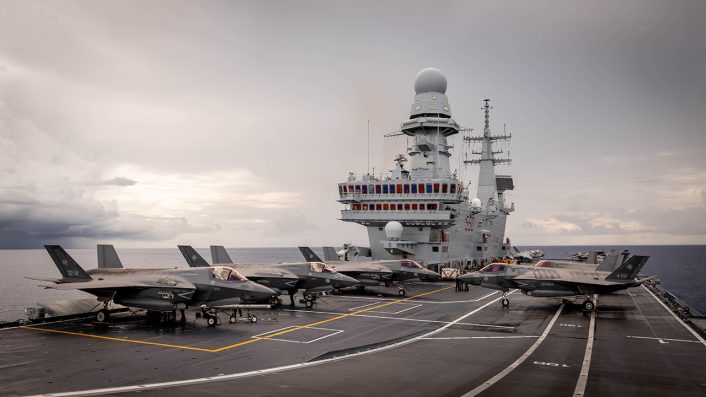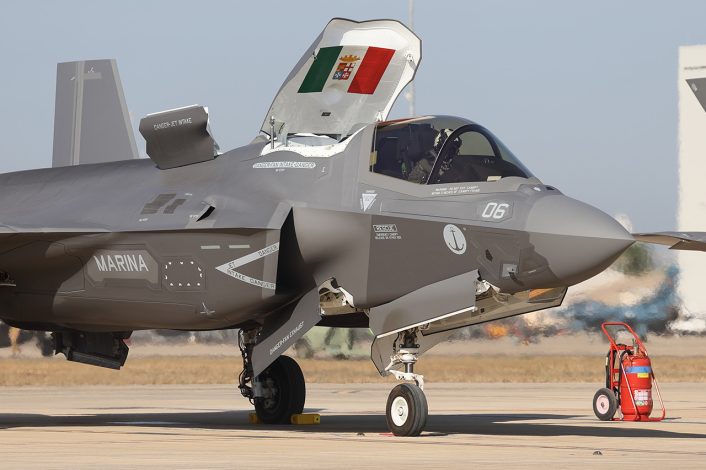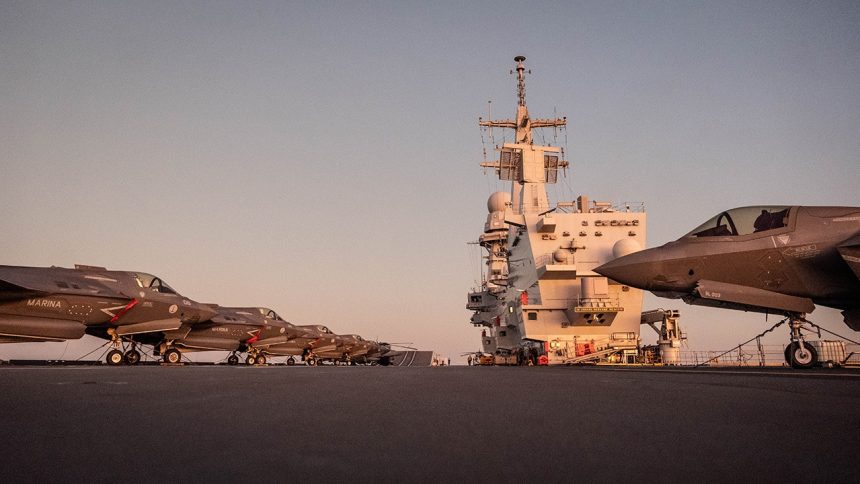The IOC (Initial Operational Capability) was achieved after 2,600 flight hours, as the joint F-35B component is embarked aboard Cavour aircraft carrier currently involved in her first Indo-Pacific cruise.
“Following the results obtained by the Carrier Strike Group and the achievement of the objectives of the embarked air component, today we can declare the achievement of the Initial Operational Capability (IOC) of the 5th generation expeditionary sea-based national capability,” announced the Chief of Staff of the Italian Navy, Admiral Enrico Credendino, on Aug. 28, 2024, aboard the aircraft carrier Cavour, moored at the Yokosuka Naval Base in Japan, as part of the operational projection campaign in the Indo-Pacific of the national Carrier Strike Group.
The Initial Operational Capability of the F-35B component was declared after logging over 2,600 flight hours, certifying “the ability to make available, through the 5th generation aircraft embarked on the Cavour aircraft carrier, offensive and defensive missions to counter the air threats, engage land and naval targets and suppress enemy air defenses, projecting into remote areas along with the Carrier Strike Group, in complete logistical autonomy,” an official release by the naval service states.
The F-35B flight group established aboard Cavour aircraft carrier is currently composed by six F-35B aircraft from the Navy’s Gruppo Aerei Imbarcati (Embarked Air Squadron – that operates both the Lightning II and the AV-8B+ Harrier) and two belonging to the 32° Stormo (Wing) of the Italian Air Force: noteworthy, the IOC has been declared for the entire sea-based air component of the Italian Defense, including the Air Force share.
The Italian Navy and Air Force have achieved growing synergies in recent years, culminating in the current Indo-Pacific campaign, which has allowed them to accelerate the development process of a national embarked STOVL capability “which further increases Italy’s readiness and ability to contribute effectively, together with its allies, to global security and stability, wherever necessary.”

Currently, the Navy’s F-35Bs are based at Amendola Air Base for more efficient fleet management until a sufficient number of aircraft are available to be stationed at Grottaglie Naval Air Station. This co-basing approach enhances the standardization of Techniques, Tactics, and Procedures. Additionally, both services frequently train together in expeditionary scenarios from austere locations and aboard the Italian Navy’s aircraft carrier, ITS Cavour.
“Our country is the only one in the European Union with a Carrier Strike Group with 5th generation assets and, together with those from the US and UK, constitutes the very small nucleus of NATO allies with this capability. In this context, the Carrier Strike Group with the F-35Bs is a concrete representation of Italy’s rank as a medium regional power with a strong maritime connotation, and represents a tool of reassurance for allies or deterrence against potential adversaries: a versatile and flexible device to project and be influential wherever necessary.”
“With the IOC – added Admiral Credendino – the Maritime Component of Defense takes a significant step forward in expressing the ability to project forces from the sea even in operational theaters far from the usual gravitational basins, for extended periods of time, pursuing complete interoperability and interchangeability in joint operations with allies and partners: one of the main objectives of the Carrier Strike Group Campaign in the Indo-Pacific”.
Cavour’s Indo-Pacific Mission
The Cavour Carrier Strike Group (CSG) departed Italy in June, shortly after completing its operational certification during the multi-domain Mare Aperto 2024 exercise. The deployment aimed to assess and certify the air component’s capabilities, with the goal to achieve Initial Operational Capability by the end of the mission.
After transiting the Indian Ocean, the CSG reached Australia for one of the key events of the deployment: the biennial Pitch Black exercise. The 2024 edition was the largest in the exercise’s 43-year history, featuring participation from 21 nations and over 140 aircraft, with around 4,435 personnel involved.
For the first time, the exercise included a dedicated aircraft carrier, thanks to the involvement of ITS Cavour. This provided an opportunity for collaboration with the U.S. Marine Corps’ Marine Medium Tiltrotor Squadron 268 (Reinforced), which conducted deck landing qualifications with their MV-22 Osprey tiltrotors on Cavour.
Following the exercise, the Cavour CSG sailed to Japan, where it joined the USS Lincoln for the Multi-Large Deck Event. The CSG then made a logistical stop in Guam before resuming its journey for joint drills with Japan’s Carrier Aviation Component.
The Italian aircraft carrier will return to Italy in November.
Current status of the Italian F-35 component
Since receiving its first aircraft in 2015, the Italian Air Force has acquired 24 F-35A and 2 F-35B aircraft, stationed at bases in Italy and the U.S. The F-35A fleet is assigned to Ghedi Air Base and Amendola Air Base in Italy, as well as Luke Air Force Base in Arizona, where the 156° Gruppo (Squadron) was recently reactivated. The F-35B aircraft operate from Amendola under the 13th Squadron and the CSAS (Centro Supporto Addestramento e Standardizzazione), working in coordination with the Italian Navy, which currently operates six F-35Bs.
According to the latest reports, the Italian Air Force plans to expand its fleet to 75 F-35A and 20 F-35B aircraft, an increase from the original plan of 60 F-35A and 15 F-35B—a total addition of 20 aircraft (15 A models and 5 B models). Although no new orders or negotiations have been confirmed, this is the first time these updated figures have been publicly shared as either plans or requirements.
There has been no update regarding a possible increase in the F-35B order for the Italian Navy, which is currently set to receive 15 aircraft. However, the Air Force’s expanded acquisition of F-35Bs could lead to a review of the Navy’s order, potentially raising it to 20 units.










